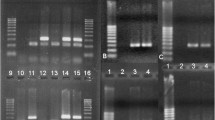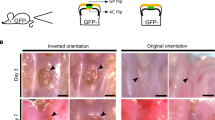Abstract
Background: The purpose of this study is to illustrate the routes of migration of precartilaginous cells from the perichondrial ring of LaCroix, as a potential reservoir for growth-plate germ cells. Methods: Chondrocytes derived from the ring of LaCroix of young chicks’ proximal tibia were cultured in vitro and transfected with adenovirus vector containing the gene encoding for Escherichia coli (beta)-galactosidase (lacZ) gene, which allows assessment of the migratory routes of these cells. The lacZ- transfected cells were injected back into the perichondrial ring of LaCroix of young chicks’ proximal tibias. Four weeks later the migration root was assessed microscopically. Results: Injection of cells derived from the ring of LaCroix of neonate chicks, transfected in culture with adenoviruses containing LacZ reporter gene, allows the assessment of migratory potential of these cells. Stained cells were found at the outer layer of the epiphysis, particularly in areas adjacent to the perichondrial ring. Further longitudinal histopathological studies along the bone axis demonstrated a condensed layer of the stained cells arranged horizontally along parts of the physis. Conclusion: The perichondrial ring of LaCroix represents a potential reservoir of growth-plate germ cells in young chicks.
Résumé
Le but de cette étude est d’étudier la circulation des cellules souches précartilagineuses provenant de la virole périchondrale de LaCroix considérée comme un réservoir potentiel de ces cellules. Méthode: les chondrocytes provenant de la virole périchondrale de LaCroix prélevés au niveau de l’extrémité supérieure du tibia chez de jeunes poulets ont été cultivés in vitro et transplantés à l’aide d’un adénovirus codant le gène beta galactosidase (lacZ). Les cellules lacZ ainsi transplantées ont été injectées dans la virole périchondrale de l’extrémité supérieure du tibia des mêmes poulets. Quatre semaines après, les migrations cellulaires ont été étudiées au microscope. Résultats: les migrations de ces cellules ont été vérifiées sur le plan histopathologique. Conclusion: On peut affirmer que la virole périchondrale de LaCroix est un réservoir potentiel de cellules souches de croissance chez les jeunes poulets.





Similar content being viewed by others
References
Chu CR, Dounchis JS, Yoshioka M et al (1997) Osteochondral repair using perichondrial cells. Clin Orthop 340:220–229
O’Driscoll SW, Recklies AD, Poole AR (1994) Chondrogenesis in periosteal explants. An organ culture model for in vitro study. J Bone Joint Surg Am 76:1042–1051
Robinson D, Hasharoni A, Nevo Z (1999) Fibroblast growth factor receptor-3 as a marker for precartilaginous stem cells. Clin Orthop 367 Suppl:S163–S175
Long F, Linsenmayer TF (1998) Regulation of growth region cartilage proliferation and differentiation by perichondrium. Development 125:1067–1073
Phemister DB (1993) Operative arrestment of longitudinal growth of bones in the treatment of deformities. J Bone Joint Surg Am 15:1–16
Rodriguez JI, Delgado E, Paniagua R (1985) Changes in young rat radius following excision of the perichondrial ring. Calcif Tissue Int 37(6):677–683
Gamble JG (1996) Development and maturation of the neuromusculoskeletal system. In: Morrissy RT, Weinstein SL (eds) Pediatric orthopedics. Lippincott-Raven, Philadelphia, pp 1–24
Shapiro F, Holtrop ME, Glimcher MJ (1997) Organization and cellular biology of the perichondrial ossification groove of ranvier: a morphological study in rabbits. J Bone Joint Surg Am 59(6):703–723 Sep
Bruder SP, Ricalton NS, Boynton RE et al (1998) Mesenchymal stem cell surface antigen SB-10 corresponds to activated leukocyte cell adhesion molecule and is involved in osteogenic differentiation. J Bone Miner Res 13:655–663
Buckwalter JA, Rosenberg L (1983) Structural changes during development in bovine fetal epiphyseal cartilage. Coll Relat Res 3(6):489–504 Nov
Santos-Ocampo S, Clovin JS, Chellaiah A, Ornitz DM (1996) Expression and biological activity of mouse fibroblast growth factor-9. J Biol Chem 271:1726–1731
Koyama E, Shimazu A, Leatherman JL et al (1996) Expression of syndecan-3 and tenscin-C: possible involvement in periosteum development. J Orthop Res 1:403–412
Author information
Authors and Affiliations
Corresponding author
Rights and permissions
About this article
Cite this article
Fenichel, I., Evron, Z. & Nevo, Z. The perichondrial ring as a reservoir for precartilaginous cells. In vivo model in young chicks’ epiphysis. International Orthopaedics (SICOT) 30, 353–356 (2006). https://doi.org/10.1007/s00264-006-0082-2
Received:
Revised:
Accepted:
Published:
Issue Date:
DOI: https://doi.org/10.1007/s00264-006-0082-2




